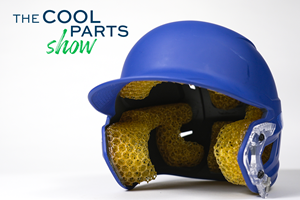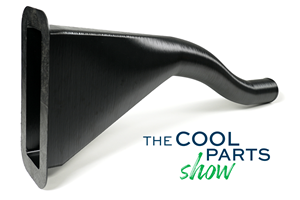Rapid Fusion’s CNC Milling Tool Enables Hybrid Manufacturing
The high-performance electro spindle provides precision milling and postprocessing of polymer 3D prints.
Share
Read Next
The high-performance electro spindle CNC milling tool can be fitted to future Zeus 3D robotic systems by the company, giving clients the speed of AM along with the precision of subtractive machining — all in one 6 × 6-m cell. Source: Rapid Fusion
UK-based Rapid Fusion has created a high-performance electro spindle CNC milling tool that provides precision milling and postprocessing of polymer 3D prints to give manufacturers the best of both additive and traditional manufacturing.
Rapid Fusion, which employs eight people at its recently opened Exeter R&D center, created the high-performance electro spindle to provide precision milling and postprocessing of polymer 3D prints.
Eight months in development, the technology can be fitted to future Zeus 3D robotic systems by the company. It will give clients the opportunity to enjoy the speed of additive manufacturing (AM) along with the precision of subtractive machining — all in one 6 × 6-m cell. This tool is well suited for high-quality molds across a range of industries — such as automotive, aerospace and marine applications — where speed to market is increasingly important.
“This CNC milling tool has the potential to be a real game changer for manufacturers and has been designed in partnership with a number of end users to ensure we deliver exactly what they need,” explained Martin Jewell, R&D director at Rapid Fusion. “3D printing can give unrivalled speed and creates molds near net shape, within 3 to 4 mm. Certain applications need even greater precision and this is where you can call in a CNC milling tool to remove the excess material.”
Going forward, the company says it will be able to offer this in one turnkey solution. “The advantages are huge,” Jewell says. “We now know we can deliver repeatable quality and, on one trial project, we reduced the lead time for a mold tool from six to eight weeks to just five days. That is some saving.”
The CNC milling tool comes equipped with a toolchanger, enabling users to swap between it and the 3D printing pellet extruder on a robot setup. “It can also efficiently handle engineering-grade materials, such as glass and carbon-filled PEI and peek polymers,” Jewell adds.
Rapid Fusion, a sister business of 3D printing hardware specialist EVO 3D, says it is committed to becoming a major player in AM platforms — all designed, built and assembled in the UK. It launched its first bespoke cell, Apollo, in 2024, which has already received significant interest for its ability to offer faster speeds than existing FDM printers (nearly 200 times quicker).
The company is just a few months away from releasing a second cell that will include the CNC milling tool, with orders already placed by a 3D printing production specialist in the UK and a construction supplier in the EU.
It is estimated that this new technology alone could generate up to 3 million euros of annual revenue and is completely designed, developed and manufactured in the South West.
“Everyone knows the UK is a fantastic breeding ground for ideas and innovation, yet we don’t commercialize enough of the new things we come up with,” Jewell says. “We’re trying to change this and the CNC milling tool will be an important weapon in our product portfolio for achieving that.”
When integrated into the new robotic platform, Rapid Fusion clients will be able to tap into the best of additive and subtractive manufacturing in one solution, benefitting from a host of time, cost and operational benefits — as well as environmental savings from using less material and energy.
Rapid Fusion signed a distribution agreement with CNC World, which will be one of the main agents for the CNC milling tool and the new robotic platform when it is released.
Related Content
Q&A With Align EVP: Why the Invisalign Manufacturer Acquired Cubicure, and the Future of Personalized Orthodontics
Align Technology produces nearly 1 million unique aligner parts per day. Its acquisition of technology supplier Cubicure in January supports demand for 3D printed tooling and direct printed orthodontic devices at mass scale.
Read MoreCopper, New Metal Printing Processes, Upgrades Based on Software and More from Formnext 2023: AM Radio #46
Formnext 2023 showed that additive manufacturing may be maturing, but it is certainly not stagnant. In this episode, we dive into observations around technology enhancements, new processes and materials, robots, sustainability and more trends from the show.
Read More3D Printed Lattices Replace Foam for Customized Helmet Padding: The Cool Parts Show #62
“Digital materials” resulting from engineered flexible polymer structures made through additive manufacturing are tunable to the application and can be tailored to the head of the wearer.
Read MoreAircraft Ducts 3D Printed in Composite Instead of Metal: The Cool Parts Show #68
Eaton’s new reinforced PEKK, tailored to aircraft applications, provides a cheaper and faster way to make ducts compared to formed aluminum.
Read MoreRead Next
Profilometry-Based Indentation Plastometry (PIP) as an Alternative to Standard Tensile Testing
UK-based Plastometrex offers a benchtop testing device utilizing PIP to quickly and easily analyze the yield strength, tensile strength and uniform elongation of samples and even printed parts. The solution is particularly useful for additive manufacturing.
Read MoreAlquist 3D Looks Toward a Carbon-Sequestering Future with 3D Printed Infrastructure
The Colorado startup aims to reduce the carbon footprint of new buildings, homes and city infrastructure with robotic 3D printing and a specialized geopolymer material.
Read MoreCrushable Lattices: The Lightweight Structures That Will Protect an Interplanetary Payload
NASA uses laser powder bed fusion plus chemical etching to create the lattice forms engineered to keep Mars rocks safe during a crash landing on Earth.
Read More





















